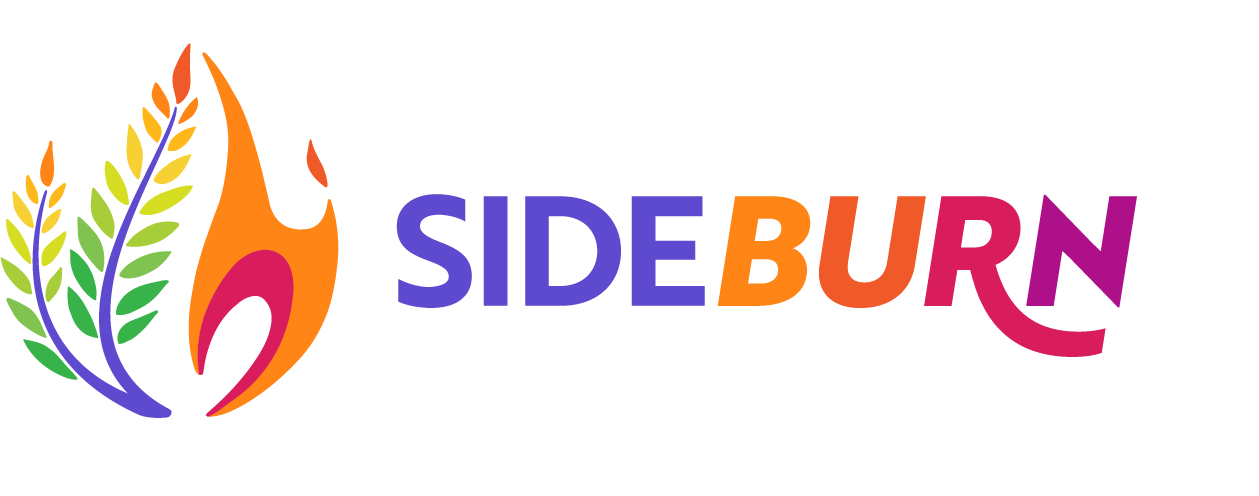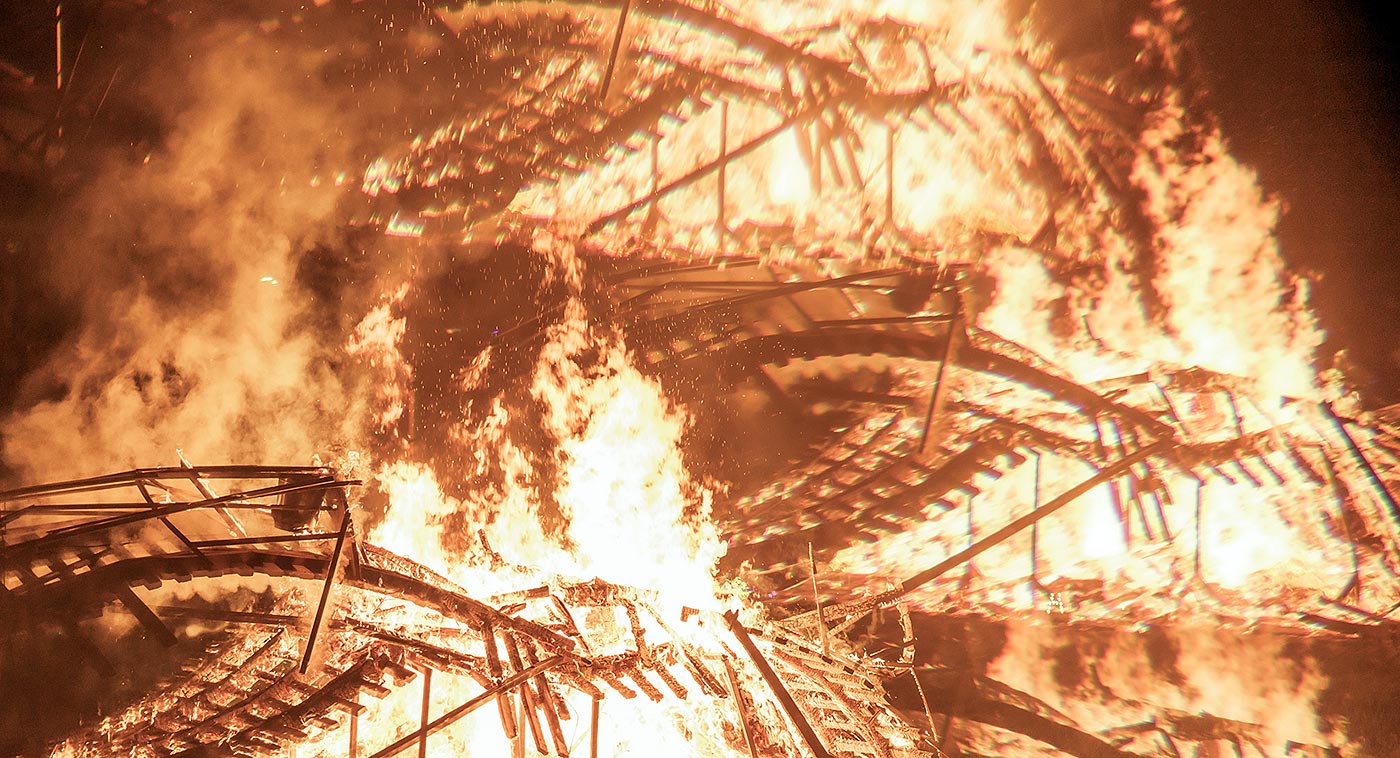For planned Art Burn projects the following items of documentation must be submitted for review and approval by FAST.
Note: Pyrotechnics are NOT permitted at the event. A maximum footprint of 20’ x 20’ wide and 20’ tall is applied to all burnable art.
Burn Plan
Your Burn Plan is a complete, detailed description of how you will prepare and burn your artwork, how you will mitigate any hazards that remain in the immediate aftermath of the burn, the people on your build team and your ignition team and any other elements you will incorporate into your burn. This is the “what” and the “how” of your burn plan.
It should include details such as:
- Burn shield to protect ground from burn scar (if applicable)
- Artwork materials & construction
- Objects to be removed from the structure before burning
- Structural hobbling to encourage the structure to fall in a particular way
- Supplementary fuel load (i.e., cordwood)
- Performance elements, if any
- Burn Circle Zones and Perimeter details
- Accelerants to be used, how they will be applied, and the safety protocols your crew will follow during application
- How the burn will be ignited
- Weather Contingency Plan (see below)
- How you will mitigate hazards on the ground after the structure falls
- Your contingency plan in case the structure does not fall
- Overnight monitoring of the ember bed
Weather Contingency Plan
All burns are subject to cancellation or rescheduling in the event of adverse weather conditions. An essential part of your Burn Scenario is your Weather Contingency Plan, which covers how you will deal with the possibility that weather conditions could develop that would prevent the burn from proceeding after combustible materials have been loaded and/or after fueling has taken place. An all-night standby is an essential part of this plan. You and your entire crew must be prepared to maintain the perimeter to keep the Restricted Zone from being entered once it has been loaded with accelerants, to avoid any unintended burning or participant injury.
Burn Timeline
Your Burn Timeline lays out the steps involved in executing your burn from start to finish, with the expected start time and duration for each step. This is the “when” and the “how long” of your burn plan.
It should include any relevant steps such as:
- Perimeter establishment
- Clearing structure contents
- Cordwood loading
- Structural hobbling
- Stowaway/straggler check
- Weather check
- Accelerant application
- Performance
- Ignition
- Combustion and collapse
- Hazard mitigation
- Perimeter release
- Crew accounting and check-out
- Overnight monitoring
Note that the items above are listed in the approximate order of occurrence for a typical burn. Every burn is unique, and your burn may have additional steps and/or a different order.
Prohibited Materials
The following materials must not be used in the construction of your project, or they must be removed before the burn:
- Paper
- Cardboard
- Paper mache
- ⅛” or ¼” plywood (must be ⅜” or thicker)
- Plywood with a veneer layer
- OSB
- MDF
- Shims
- Plastic
- Wool and leather
- Natural or synthetic fabric
- Anything likely to create large flying embers
Required Diagrams
The following Diagrams are required:
- Burn Circle Layout, including:
- Illumination: how the installation, including generators or other outlying features, will be illuminated at night.
- Burn Zones and Perimeter, showing distances from the center of the artwork.
- Perimeter Features, e.g., safety corridors, rally point, etc.
- Any other important physical features or locations.
- Burn Shield Platform, if not using decomposed granite
- Structural Details & Hobbling if you intend to do any hobbling of the structure before burning
- Special Effects Mechanisms to be used during your burn (e.g., liquid fuel dumps, etc.)
- Base Camp Layout
- Storage location(s) for flammable liquids, fuel gases or other hazardous/flammable materials.
- Storage location(s) for empty fuel containers, if different from above.
- Safety perimeters and barriers, and distances to public areas and habitations.
- 20′ wide fire lane from street to storage location(s) listed above.
- Fire extinguisher locations.
Operational Plans
Safety Plan
Your Safety Plan should describe all the measures that your crew will employ to ensure that your installation will be safe for participants, performers and crew, both during and after construction, and during any burn and subsequent clean-up.
At a minimum it should cover:
- Illumination and protection from vehicle traffic for all elements of the installation, including the artwork itself and any generators or other outlying equipment or structures.
- Types, sizes and placement of fire extinguishers or other fire suppression means that will be kept on hand.
- Location and contents of first aid kit(s).
- List of Material Safety Data Sheets.
- Safety training your crew members have.
- Safety-specific crew roles and responsibilities.
- Safety procedures and protocols.
Emergency Response Plan
No matter how comprehensive your Safety Plan, things still go wrong. Your Emergency Response Plan should list all the ways things may go wrong and expose your crew or other participants to potential injury, and how your crew will respond when they do.
At a minimum it should cover:
- Response to liquid fuel spills, small and large.
- Response to unplanned fires, small and large.
- Response to damage (or incipient damage) caused by wind, vehicle collision or other physical forces.
- Response to hazardous material exposure of crew, performer or participant.
- Response to injury sustained by crew, performer or participant.
Leave No Trace Plan
The Artist, Leave No Trace Lead and crew are responsible for all clean up at the installation site during build, during the event and after your burn. Your Leave No Trace plan describes how you will accomplish this.
At a minimum it should cover:
- Preventing and removing MOOP during build and burn preparations, especially wood chips from construction or from cordwood.
- Nightly clean-up procedure.
- Post-burn clean-up procedure, including specific details on clean-up of any pyrotechnic debris, if applicable.
- Emergency clean-up procedures (e.g., for liquid fuel spills).
- Clean-up tools and materials to be used.

